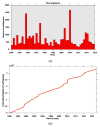Tsallis q-Statistics in Seismology
- PMID: 36981296
- PMCID: PMC10047228
- DOI: 10.3390/e25030408
Tsallis q-Statistics in Seismology
Abstract
Non-extensive statistical mechanics (or q-statistics) is based on the so-called non-additive Tsallis entropy. Since its introduction by Tsallis, in 1988, as a generalization of the Boltzmann-Gibbs equilibrium statistical mechanics, it has steadily gained ground as a suitable theory for the description of the statistical properties of non-equilibrium complex systems. Therefore, it has been applied to numerous phenomena, including real seismicity. In particular, Tsallis entropy is expected to provide a guiding principle to reveal novel aspects of complex dynamical systems with catastrophes, such as seismic events. The exploration of the existing connections between Tsallis formalism and real seismicity has been the focus of extensive research activity in the last two decades. In particular, Tsallis q-statistics has provided a unified framework for the description of the collective properties of earthquakes and faults. Despite this progress, our present knowledge of the physical processes leading to the initiation of a rupture, and its subsequent growth through a fault system, remains quite limited. The aim of this paper was to provide an overview of the non-extensive interpretation of seismicity, along with the contributions of the Tsallis formalism to the statistical description of seismic events.
Keywords: Tsallis q-entropy; complex systems; earthquakes; non-extensive statistical mechanics; seismicity.
Conflict of interest statement
The authors declare no conflict of interest. The funders had no role in the design of the study; in the collection, analyses, or interpretation of data; in the writing of the manuscript, or in the decision to publish the results.
Figures











References
-
- Telesca L., Lapenna V., Macchiato M. Spatial variability of the time-correlated behaviour in Italian seismicity. Earth Planet. Sci. Lett. 2003;212:279–290. doi: 10.1016/S0012-821X(03)00286-3. - DOI
-
- Huang Q. Seismicity changes prior to the Ms8.0 Wenchuan earthquake in Sichuan, China. Geophys. Res. Lett. 2008;35:L23308. doi: 10.1029/2008GL036270. - DOI
-
- Lennartz S., Livina V.N., Bunde A., Havlin S. Long-term memory in earthquakes and the distribution of interoccurrence times. EPL. 2008;81:69001. doi: 10.1209/0295-5075/81/69001. - DOI
-
- Telesca L., Lovallo M. Non-uniform scaling features in central Italy seismicity: A non-linear approach in investigating seismic patterns and detection of possible earthquake precursors. Geophys. Res. Lett. 2009;36:L01308. doi: 10.1029/2008GL036247. - DOI
-
- Lennartz S., Bunde A., Turcotte D.L. Modelling seismic catalogues by cascade models: Do we need long-term magnitude correlations? Geophys. J. Int. 2011;184:1214–1222. doi: 10.1111/j.1365-246X.2010.04902.x. - DOI
Publication types
LinkOut - more resources
Full Text Sources

